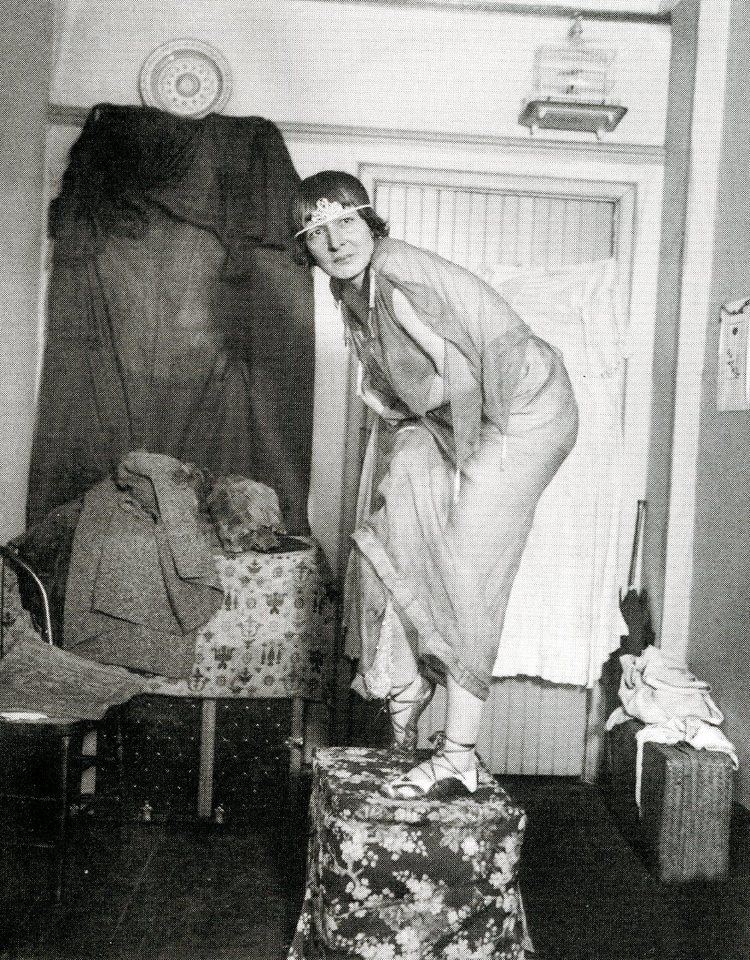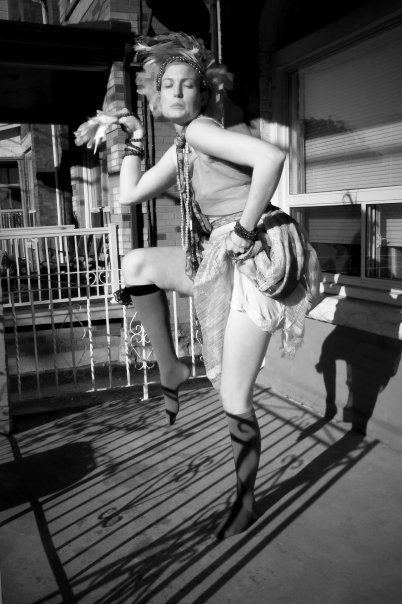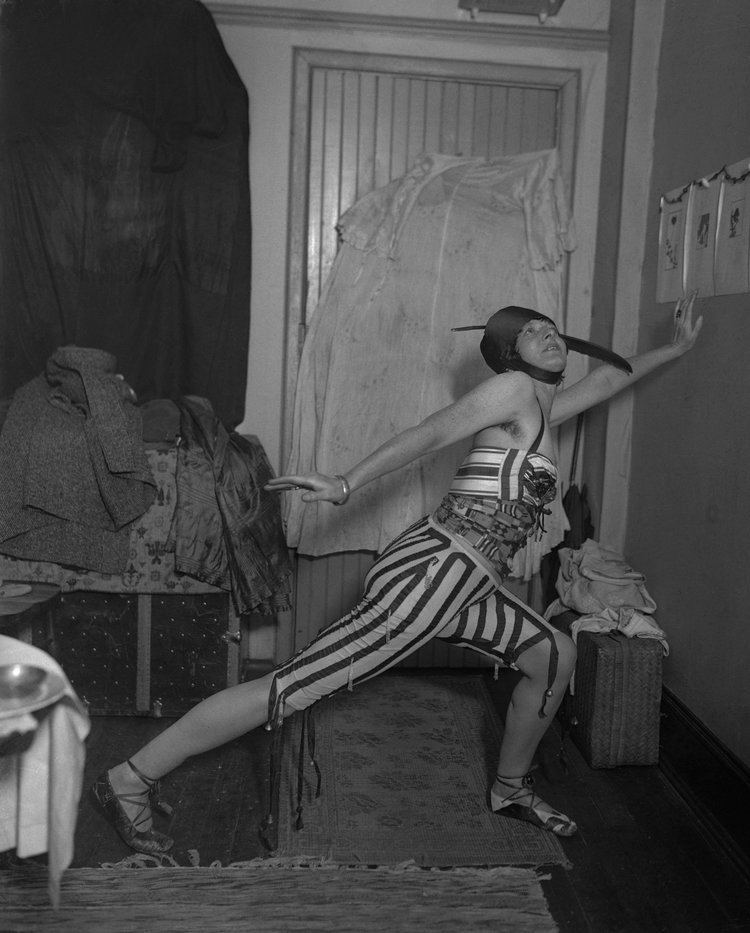Periods Avant-garde, Dada | Name Elsa Freytag-Loringhoven Known for Poetry, Sound poetry Role Artist | |
 | ||
Full Name Else Hildegard Plotz Died December 15, 1927, Paris, France Books Subjoyride: Selected Poems Similar People Djuna Barnes, Thelma Wood, James Joyce, William Goyen, John Hawkes | ||
Body sweats the uncensored writings of elsa von freytag loringhoven
Baroness Elsa von Freytag-Loringhoven (sometimes also called Else von Freytag-von Loringhoven) (12 July 1874 – 15 December 1927) was a German avant-garde, Dadaist artist and poet who worked for several years in Greenwich Village, New York. She has been claimed as the originator of Fountain, usually ascribed to Marcel Duchamp.
Contents
- Body sweats the uncensored writings of elsa von freytag loringhoven
- Fountain marcel duchamp or elsa von freytag loringhoven
- Early life
- Work
- Poetry
- Collage performance and assemblage
- Death
- Biographies
- References

Her provocative poetry was published posthumously in 2011 in Body Sweats: The Uncensored Writings of Elsa von Freytag-Loringhoven. The New York Times praised the book as one of the notable art books of 2011.

Fountain marcel duchamp or elsa von freytag loringhoven
Early life

Freytag-Loringhoven was born Else Hildegard Plötz in Swinemünde (Świnoujście), in Pomerania, Germany, to Adolf Plötz and Ida Marie Kleist. Her father was a mason. She trained and worked as an actress and vaudeville performer and had numerous affairs with artists in Berlin, Munich and Italy. She studied art in Dachau, near Munich.

She married Berlin-based architect, August Endell in a civil service on August 22, 1901 in Berlin, becoming Else Endell. They had an open relationship, and in 1902 she became romantically involved with a friend of Endell's, the minor poet and translator Felix Paul Greve (later the Canadian author Frederick Philip Grove). After the trio travelled together to Palermo, Sicily in late January 1903, the Endells' marriage disintegrated and they divorced in 1906. Although their separation was acrimonious, she dedicated several satirical poems to Endell. In 1906, she and Greve returned to Berlin, where they were married on August 22, 1907.

By 1909, Greve was in deep financial trouble. With his wife's help, he staged a suicide and departed for North America in late July 1909. In July 1910, Else joined him in the United States, where they operated a small farm in Sparta, Kentucky, not far from Cincinnati. Greve suddenly deserted her in 1911 and went west to a bonanza farm near Fargo, North Dakota, and to Manitoba in 1912. There are no records of a divorce from Greve. She started modeling for artists in Cincinnati, and made her way east via West Virginia and Philadelphia, before she married her third husband, the German Baron Leopold von Freytag-Loringhoven (son of Hugo von Freytag-Loringhoven), in November 1913 in New York. There, she became known as "the dadaist Baroness Elsa von Freytag-Loringhoven".
Work

In New York City, Freytag-Loringhoven supported herself by working in a cigarette factory and by posing as a model for artists such as Louis Bouché, George Biddle, and Man Ray. She also appeared in works by Man Ray, George Grantham Bain and others; lithography by George Biddle; and paintings by Theresa Bernstein.
Poetry
The Baroness was given a platform for her poetry in The Little Review, where, starting in 1918, her work was featured alongside chapters of James Joyce's Ulysses. Jane Heap considered the Baroness "the first American dada." She was an early female pioneer of sound poetry, but also made creative use of the dash, while many of her portmanteau compositions, such as “Kissambushed” and “Phalluspistol,” present miniature poems. Most of her poems remained unpublished until the publications of Body Sweats. Her personal papers were preserved after her death by her editor, literary agent, artistic collaborator, and lover Djuna Barnes. University of Maryland Libraries acquired a collection of her work with the papers of Barnes in 1973 and subsequently separated von Freytag-Lorninghoven's papers and treated them as an individual collection. The collection contains correspondences, visual poems, and other artistic/literary works by the artist. The University of Maryland's special collections has an extensive digital archive of her manuscripts.
Collage, performance and assemblage
In New York, the Baroness also worked on assemblage sculptures and paintings, creating art out of the rubbish and refuse she collected from the streets. The Baroness was also known to construct elaborate costumes from found objects, creating a "kind of living collage" that erased the boundaries between life and art.
Few artworks by the Baroness exist today. Several known found object works include Enduring Ornament (1913), Earring-Object (ca. 1917-1919), Cathedral (ca. 1918) and Limbswish (ca. 1920). Rediscovered by the Whitney Museum in New York City in 1996, her Portrait of Marcel Duchamp (no longer extant) is another example of her ready-made pieces.
There has been substantial new research indicating that some artworks attributed to other artists of the period can now either be attributed to the Baroness, or raise the possibility that she may have created the works. One work, called God (1917) had for a number of years been attributed to the artist Morton Livingston Schamberg. The Philadelphia Museum of Art, whose collection includes God, now credits the Baroness as a co-artist of this piece. However, according to the scholar Francis Naumann, it is reasonable to conclude, based on the works known to have been made by her, that the Baroness most likely came up with the concept of combining the two elements of the sculpture (a cast iron plumbing trap mounted upside down on top of a wooden mitre box) and provided the title, while Schamberg assembled and photographed the piece.
The Baroness may have been involved in the creation of Marcel Duchamp's famous ready-made, Fountain (1917). As Irene Gammel has documented, the choice of a urinal as an art work is more in line with Freytag-Loringhoven's scatological aesthetics than with Duchamp's. Moreover, Duchamp indicated in a letter to his sister Suzanne, written in 1917, that a female friend of his had sent him the urinal for submission to Society of Independent Artists Exhibition: "Une de mes amies sous un pseudonyme masculin, Richard Mutt, avait envoyé une pissotière en porcelaine comme sculpture" ("One of my female friends, under a male pseudonym, Richard Mutt, had sent a porcelain urinal as a sculpture.")
Death
In 1923, Freytag-Loringhoven went back to Berlin, expecting better opportunities to make money, but instead found an economically devastated post-World War I Germany. Despite her difficulties in the Weimar Republic, she remained in Germany, penniless and on the verge of insanity. Several friends in the expatriate community, in particular Bryher, Djuna Barnes, Berenice Abbott, and Peggy Guggenheim, provided emotional and financial support.
Freytag-Loringhoven's mental stability steadily improved when she was able to move to Paris. She died on 14 December 1927 of gas suffocation after it was left on in her flat. She may have forgotten to turn the gas off, or someone else may have turned it on; the circumstances were not clear. She is buried in Père Lachaise Cemetery, Paris.
In 1943, Freytag-Loringhoven's work was included in Guggenheim's show Exhibition by 31 Women at the Art of This Century gallery in New York.
Biographies
The Baroness was one of the “characters, one of the terrors of the district,” wrote her first biographer Djuna Barnes, whose book remained unfinished. In Irrational Modernism: A Neurasthenic History of New York Dada, Amelia Jones provides a revisionist history of New York Dada, expressed through the life and works of The Baroness. The 2002 biography, Baroness Elsa: Gender, Dada and Everyday Modernity, by Irene Gammel, makes a case for the Baroness’s artistic brilliance and avant-garde spirit. The book explores the Baroness’s personal and artistic relationships with Djuna Barnes, Berenice Abbott, and Jane Heap, as well as with Duchamp, Man Ray, and William Carlos Williams. It shows the Baroness breaking every erotic boundary, reveling in anarchic performance, but the biography also presents her as Elsa’s friend Emily Coleman saw her, “not as a saint or a madwoman, but as a woman of genius, alone in the world, frantic.”
In 2013, the artists Lily Benson and Cassandra Guan released The Filmballad of Mamadada, an experimental biopic on the Baroness. The story of The Baroness' life was told through contributions from over 50 artists and filmmakers. The film premiered at Copenhagen International Documentary Festival and was described as a, "playful and chaotic experiment that posits a return to a grand collective narrative via the postqueer populism of YouTube and crowdsourcing," by Art Forum.
